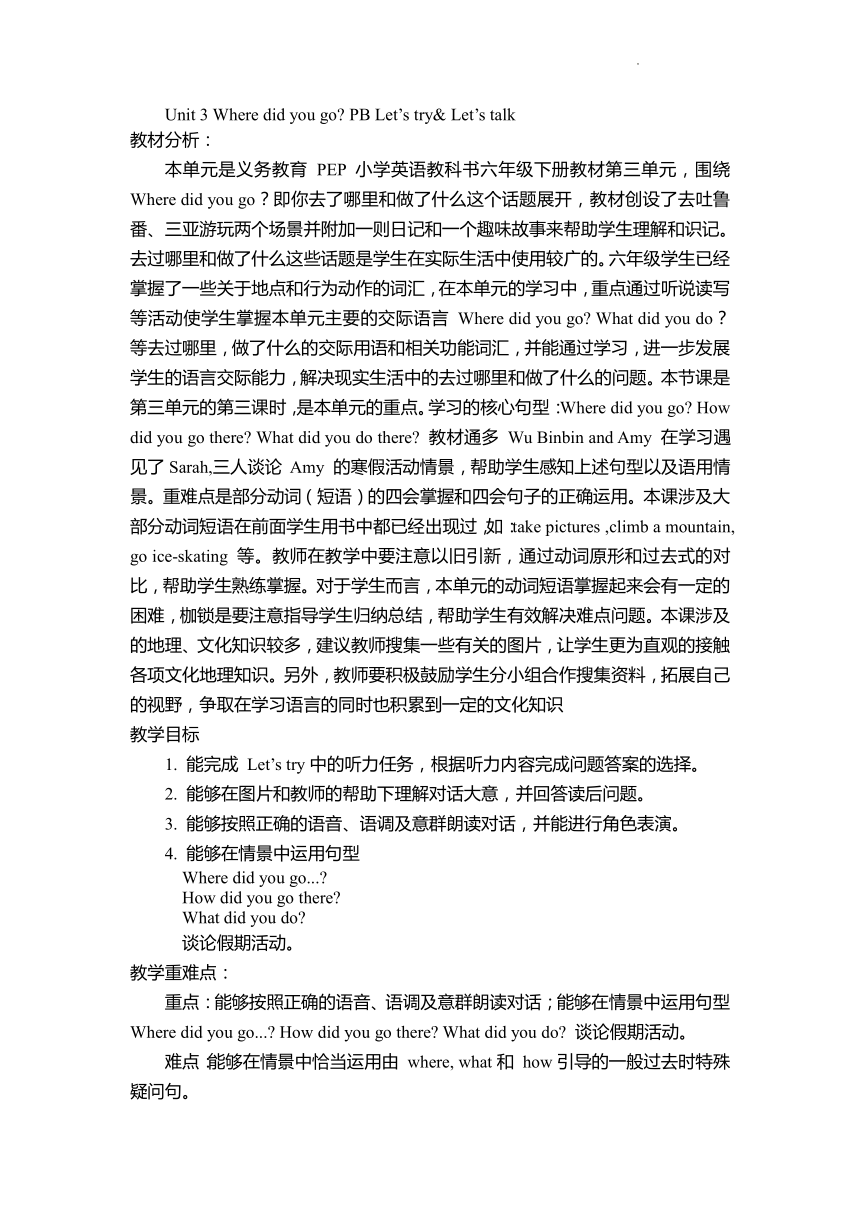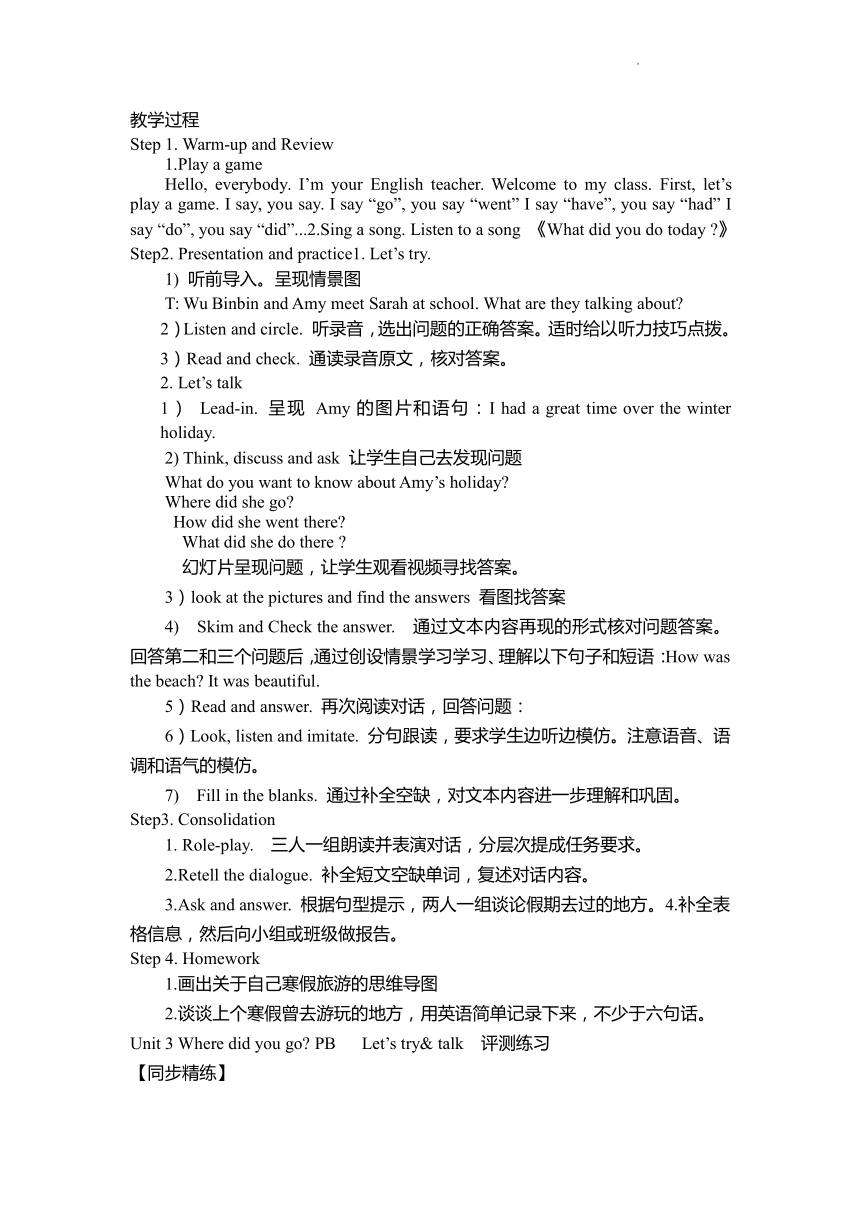Unit 3 Where did you go? Part B Let's try &let's talk 教案(含教学反思)
文档属性
| 名称 | Unit 3 Where did you go? Part B Let's try &let's talk 教案(含教学反思) |

|
|
| 格式 | zip | ||
| 文件大小 | 32.4KB | ||
| 资源类型 | 教案 | ||
| 版本资源 | 人教版(PEP) | ||
| 科目 | 英语 | ||
| 更新时间 | 2022-03-27 15:43:53 | ||
图片预览


文档简介
Unit 3 Where did you go PB Let’s try& Let’s talk
教材分析:
本单元是义务教育 PEP 小学英语教科书六年级下册教材第三单元,围绕 Where did you go?即你去了哪里和做了什么这个话题展开,教材创设了去吐鲁番、三亚游玩两个场景并附加一则日记和一个趣味故事来帮助学生理解和识记。去过哪里和做了什么这些话题是学生在实际生活中使用较广的。六年级学生已经掌握了一些关于地点和行为动作的词汇,在本单元的学习中,重点通过听说读写等活动使学生掌握本单元主要的交际语言 Where did you go What did you do?等去过哪里,做了什么的交际用语和相关功能词汇,并能通过学习,进一步发展学生的语言交际能力,解决现实生活中的去过哪里和做了什么的问题。本节课是第三单元的第三课时,是本单元的重点。学习的核心句型:Where did you go How did you go there What did you do there 教材通多 Wu Binbin and Amy 在学习遇见了Sarah,三人谈论 Amy 的寒假活动情景,帮助学生感知上述句型以及语用情景。重难点是部分动词(短语)的四会掌握和四会句子的正确运用。本课涉及大部分动词短语在前面学生用书中都已经出现过,如:take pictures ,climb a mountain, go ice-skating 等。教师在教学中要注意以旧引新,通过动词原形和过去式的对比,帮助学生熟练掌握。对于学生而言,本单元的动词短语掌握起来会有一定的困难,枷锁是要注意指导学生归纳总结,帮助学生有效解决难点问题。本课涉及的地理、文化知识较多,建议教师搜集一些有关的图片,让学生更为直观的接触各项文化地理知识。另外,教师要积极鼓励学生分小组合作搜集资料,拓展自己的视野,争取在学习语言的同时也积累到一定的文化知识
教学目标
1. 能完成 Let’s try中的听力任务,根据听力内容完成问题答案的选择。
2. 能够在图片和教师的帮助下理解对话大意,并回答读后问题。
3. 能够按照正确的语音、语调及意群朗读对话,并能进行角色表演。
4. 能够在情景中运用句型
Where did you go...
How did you go there
What did you do
谈论假期活动。
教学重难点:
重点:能够按照正确的语音、语调及意群朗读对话;能够在情景中运用句型 Where did you go... How did you go there What did you do 谈论假期活动。
难点:能够在情景中恰当运用由 where, what和 how引导的一般过去时特殊疑问句。
教学过程
Step 1. Warm-up and Review
1.Play a game
Hello, everybody. I’m your English teacher. Welcome to my class. First, let’s play a game. I say, you say. I say “go”, you say “went” I say “have”, you say “had” I say “do”, you say “did”...2.Sing a song. Listen to a song 《What did you do today 》Step2. Presentation and practice1. Let’s try.
1) 听前导入。呈现情景图
T: Wu Binbin and Amy meet Sarah at school. What are they talking about
2)Listen and circle. 听录音,选出问题的正确答案。适时给以听力技巧点拨。3)Read and check. 通读录音原文,核对答案。
2. Let’s talk
1) Lead-in. 呈现 Amy的图片和语句:I had a great time over the winter holiday.
2) Think, discuss and ask 让学生自己去发现问题
What do you want to know about Amy’s holiday
Where did she go
How did she went there
What did she do there
幻灯片呈现问题,让学生观看视频寻找答案。
3)look at the pictures and find the answers 看图找答案
4) Skim and Check the answer. 通过文本内容再现的形式核对问题答案。回答第二和三个问题后,通过创设情景学习学习、理解以下句子和短语:How was the beach It was beautiful.
5)Read and answer. 再次阅读对话,回答问题:
6)Look, listen and imitate. 分句跟读,要求学生边听边模仿。注意语音、语调和语气的模仿。
7) Fill in the blanks. 通过补全空缺,对文本内容进一步理解和巩固。
Step3. Consolidation
1. Role-play. 三人一组朗读并表演对话,分层次提成任务要求。
2.Retell the dialogue. 补全短文空缺单词,复述对话内容。
3.Ask and answer. 根据句型提示,两人一组谈论假期去过的地方。4.补全表格信息,然后向小组或班级做报告。
Step 4. Homework
1.画出关于自己寒假旅游的思维导图
2.谈谈上个寒假曾去游玩的地方,用英语简单记录下来,不少于六句话。
Unit 3 Where did you go PB Let’s try& talk 评测练习
【同步精练】
一、写出
A)中动词的过去式,并选用合适的词补全 B)中的句子。
A) 1. go __ 2. buy ___ 3. eat _____ 4. take __ 5. ride ____
B)
1. This morning I ____ some bad fruit and didn’t feel well.
2. Did you _____ pictures on your holiday
3. It was Children’s Day yesterday. My mother ______a toy bear for me.
4. —Where did you go, Vera
—Mt. Tianshan. And I ____ a horse there.
5. Last Saturday I _____ fishing with my parents.
二、选择恰当的句子补全对话,然后圈出正确的单词或短语。
A. How did you go there B. Where did you go over the winter holiday
C. What did you do there D. Can I see your pictures sometime
E. Did you like it Sarah:
1. ____ Amy: My family and I (go /went) to Sanya.
Binbin: Really 2 __________
Amy: Yes, it ( is / was) so warm.
Sarah: Hainan is far from here. 3 ____________
Amy: We went there by plane.
Binbin: How (was / were) the beach 4 _______
Amy: It was beautiful. I (take /took) lots of pictures, and I also ( go swimming /went swimming).
Sarah: Sounds great! 5______Amy: Sure.
三、情景会话,选择恰当的选项填在相应的横线上。
A. Oh, that’s good exercise.
B. Can I see your pictures
C. We had a picnic and went fishing.
D. Where did you go over your holiday
E. How did you go there
Sam:Hi, David! (1)_________
David:I went to the countryside with my parents.
Sam:(2)________
David:We rode our bikes there.
Sam: (3)________ What did you do in the countryside
David:(4) _______And I took lots of pictures, too.
Sam: Cool! (5)_________
David: Of course.
四、阅读短文,判断正(T)误(F)。
One day Mary went shopping by car. She stopped her car near a supermarket. She bought lots of vegetables and wanted to put them in the car. But Mary couldn’t open the door of the car, so she asked a police officer for help. The police officer was friendly, and he wanted to help Mary open the car door. Just then a young man came up and shouted (喊), “What are you doing with my car ” Mary had a look at the car’s number. Oh! The car isn’t hers. ( )
1. Mary stopped her car near the park.( )
2. Mary bought some gifts for her mother.( )
3. The police officer thought the car was Mary’s.( )
4. Finally, the police officer opened the car door. ( )
5 . From the story, we know Mary made a mistake (错误). ( )
参考答案
一、A) 1. went 2. bought 3. ate 4. took 5. Rode
B) 1. ate 2. take 3. bought 4. rode 5. Went
二、1-5BEACD
圈出的单词:went, was, was, took, went swimming
三、1-5DEACB四 1-5FFTFT
教学反思
本课的教学内容是 PEP 版小学六年级英语下册 Unit3where did you go 第四课时 Part B Let’s try and let’s learn。这节课继续学习过去式,“where did you go” “what did you do there” “how did you go there”学生已经基本掌握,需要练习来巩固,而把目标定为要求学生重点掌握动词的过去式,所以在教学中引导学生正确运用并总结动词过去式是我这节课教学的难点。教学伊始,通过唱英语歌曲《What did you do today 》调动学生学习的情绪,让同学先了解一下本课堂的内容,然后运用图片教学。从学生操练反馈的情况看,学生借助 PPT 能完成对话,但仅限于机械模仿,交际性不够突出。
反思一:靠持续不断的语言知识,而不是“玩”来培养学生持久的兴趣。小学英语教学要重视培养兴趣,但单靠唱歌、游戏不能培养学生持久的兴趣。新鲜劲儿一过,孩子们就会厌倦。所以,唱歌游戏应该作为学生学习英语语言知识、技能的部分手段,而不是培养兴趣的唯一手段。可以采用多种手段帮助学生在记忆力强的时期多记单词,多学习语言规则,并尽可能多创造模仿的机会,提高学生的语音和语调。在英语学习中,听、说、读、写、译五种能力是可以互补的。真正做到听说先行,读写跟上。光听说不读写,很难收到高效。只靠模仿不培养学习能力,也难减轻学习负担。
反思二、英语应用能力需要相应的词汇。“不学习语言规则、不掌握相当数量的词汇,英语应用能力就是空中楼阁”。目前在低年级的英语教学中,如不要求学生掌握词汇,而只要求学生能根据提示或图片说出该单词,其本质无非是要学生们死记硬背,鹦鹉学舌。
反思三:如何做好两个覆盖,学习要全面覆盖所学知识、全面覆盖全体学生。不遗漏任何一个知识点,不能冷落“差生”。今后的教学中,一方面放手给学生学习、展示,另一方面加强评价机制的利用,师评价、生评价及组评价并用。多创设与学生生活紧密联系的情境,让学生在掌握新知的同时,能在具体的情境中灵活运用句式进行交际
教材分析:
本单元是义务教育 PEP 小学英语教科书六年级下册教材第三单元,围绕 Where did you go?即你去了哪里和做了什么这个话题展开,教材创设了去吐鲁番、三亚游玩两个场景并附加一则日记和一个趣味故事来帮助学生理解和识记。去过哪里和做了什么这些话题是学生在实际生活中使用较广的。六年级学生已经掌握了一些关于地点和行为动作的词汇,在本单元的学习中,重点通过听说读写等活动使学生掌握本单元主要的交际语言 Where did you go What did you do?等去过哪里,做了什么的交际用语和相关功能词汇,并能通过学习,进一步发展学生的语言交际能力,解决现实生活中的去过哪里和做了什么的问题。本节课是第三单元的第三课时,是本单元的重点。学习的核心句型:Where did you go How did you go there What did you do there 教材通多 Wu Binbin and Amy 在学习遇见了Sarah,三人谈论 Amy 的寒假活动情景,帮助学生感知上述句型以及语用情景。重难点是部分动词(短语)的四会掌握和四会句子的正确运用。本课涉及大部分动词短语在前面学生用书中都已经出现过,如:take pictures ,climb a mountain, go ice-skating 等。教师在教学中要注意以旧引新,通过动词原形和过去式的对比,帮助学生熟练掌握。对于学生而言,本单元的动词短语掌握起来会有一定的困难,枷锁是要注意指导学生归纳总结,帮助学生有效解决难点问题。本课涉及的地理、文化知识较多,建议教师搜集一些有关的图片,让学生更为直观的接触各项文化地理知识。另外,教师要积极鼓励学生分小组合作搜集资料,拓展自己的视野,争取在学习语言的同时也积累到一定的文化知识
教学目标
1. 能完成 Let’s try中的听力任务,根据听力内容完成问题答案的选择。
2. 能够在图片和教师的帮助下理解对话大意,并回答读后问题。
3. 能够按照正确的语音、语调及意群朗读对话,并能进行角色表演。
4. 能够在情景中运用句型
Where did you go...
How did you go there
What did you do
谈论假期活动。
教学重难点:
重点:能够按照正确的语音、语调及意群朗读对话;能够在情景中运用句型 Where did you go... How did you go there What did you do 谈论假期活动。
难点:能够在情景中恰当运用由 where, what和 how引导的一般过去时特殊疑问句。
教学过程
Step 1. Warm-up and Review
1.Play a game
Hello, everybody. I’m your English teacher. Welcome to my class. First, let’s play a game. I say, you say. I say “go”, you say “went” I say “have”, you say “had” I say “do”, you say “did”...2.Sing a song. Listen to a song 《What did you do today 》Step2. Presentation and practice1. Let’s try.
1) 听前导入。呈现情景图
T: Wu Binbin and Amy meet Sarah at school. What are they talking about
2)Listen and circle. 听录音,选出问题的正确答案。适时给以听力技巧点拨。3)Read and check. 通读录音原文,核对答案。
2. Let’s talk
1) Lead-in. 呈现 Amy的图片和语句:I had a great time over the winter holiday.
2) Think, discuss and ask 让学生自己去发现问题
What do you want to know about Amy’s holiday
Where did she go
How did she went there
What did she do there
幻灯片呈现问题,让学生观看视频寻找答案。
3)look at the pictures and find the answers 看图找答案
4) Skim and Check the answer. 通过文本内容再现的形式核对问题答案。回答第二和三个问题后,通过创设情景学习学习、理解以下句子和短语:How was the beach It was beautiful.
5)Read and answer. 再次阅读对话,回答问题:
6)Look, listen and imitate. 分句跟读,要求学生边听边模仿。注意语音、语调和语气的模仿。
7) Fill in the blanks. 通过补全空缺,对文本内容进一步理解和巩固。
Step3. Consolidation
1. Role-play. 三人一组朗读并表演对话,分层次提成任务要求。
2.Retell the dialogue. 补全短文空缺单词,复述对话内容。
3.Ask and answer. 根据句型提示,两人一组谈论假期去过的地方。4.补全表格信息,然后向小组或班级做报告。
Step 4. Homework
1.画出关于自己寒假旅游的思维导图
2.谈谈上个寒假曾去游玩的地方,用英语简单记录下来,不少于六句话。
Unit 3 Where did you go PB Let’s try& talk 评测练习
【同步精练】
一、写出
A)中动词的过去式,并选用合适的词补全 B)中的句子。
A) 1. go __ 2. buy ___ 3. eat _____ 4. take __ 5. ride ____
B)
1. This morning I ____ some bad fruit and didn’t feel well.
2. Did you _____ pictures on your holiday
3. It was Children’s Day yesterday. My mother ______a toy bear for me.
4. —Where did you go, Vera
—Mt. Tianshan. And I ____ a horse there.
5. Last Saturday I _____ fishing with my parents.
二、选择恰当的句子补全对话,然后圈出正确的单词或短语。
A. How did you go there B. Where did you go over the winter holiday
C. What did you do there D. Can I see your pictures sometime
E. Did you like it Sarah:
1. ____ Amy: My family and I (go /went) to Sanya.
Binbin: Really 2 __________
Amy: Yes, it ( is / was) so warm.
Sarah: Hainan is far from here. 3 ____________
Amy: We went there by plane.
Binbin: How (was / were) the beach 4 _______
Amy: It was beautiful. I (take /took) lots of pictures, and I also ( go swimming /went swimming).
Sarah: Sounds great! 5______Amy: Sure.
三、情景会话,选择恰当的选项填在相应的横线上。
A. Oh, that’s good exercise.
B. Can I see your pictures
C. We had a picnic and went fishing.
D. Where did you go over your holiday
E. How did you go there
Sam:Hi, David! (1)_________
David:I went to the countryside with my parents.
Sam:(2)________
David:We rode our bikes there.
Sam: (3)________ What did you do in the countryside
David:(4) _______And I took lots of pictures, too.
Sam: Cool! (5)_________
David: Of course.
四、阅读短文,判断正(T)误(F)。
One day Mary went shopping by car. She stopped her car near a supermarket. She bought lots of vegetables and wanted to put them in the car. But Mary couldn’t open the door of the car, so she asked a police officer for help. The police officer was friendly, and he wanted to help Mary open the car door. Just then a young man came up and shouted (喊), “What are you doing with my car ” Mary had a look at the car’s number. Oh! The car isn’t hers. ( )
1. Mary stopped her car near the park.( )
2. Mary bought some gifts for her mother.( )
3. The police officer thought the car was Mary’s.( )
4. Finally, the police officer opened the car door. ( )
5 . From the story, we know Mary made a mistake (错误). ( )
参考答案
一、A) 1. went 2. bought 3. ate 4. took 5. Rode
B) 1. ate 2. take 3. bought 4. rode 5. Went
二、1-5BEACD
圈出的单词:went, was, was, took, went swimming
三、1-5DEACB四 1-5FFTFT
教学反思
本课的教学内容是 PEP 版小学六年级英语下册 Unit3where did you go 第四课时 Part B Let’s try and let’s learn。这节课继续学习过去式,“where did you go” “what did you do there” “how did you go there”学生已经基本掌握,需要练习来巩固,而把目标定为要求学生重点掌握动词的过去式,所以在教学中引导学生正确运用并总结动词过去式是我这节课教学的难点。教学伊始,通过唱英语歌曲《What did you do today 》调动学生学习的情绪,让同学先了解一下本课堂的内容,然后运用图片教学。从学生操练反馈的情况看,学生借助 PPT 能完成对话,但仅限于机械模仿,交际性不够突出。
反思一:靠持续不断的语言知识,而不是“玩”来培养学生持久的兴趣。小学英语教学要重视培养兴趣,但单靠唱歌、游戏不能培养学生持久的兴趣。新鲜劲儿一过,孩子们就会厌倦。所以,唱歌游戏应该作为学生学习英语语言知识、技能的部分手段,而不是培养兴趣的唯一手段。可以采用多种手段帮助学生在记忆力强的时期多记单词,多学习语言规则,并尽可能多创造模仿的机会,提高学生的语音和语调。在英语学习中,听、说、读、写、译五种能力是可以互补的。真正做到听说先行,读写跟上。光听说不读写,很难收到高效。只靠模仿不培养学习能力,也难减轻学习负担。
反思二、英语应用能力需要相应的词汇。“不学习语言规则、不掌握相当数量的词汇,英语应用能力就是空中楼阁”。目前在低年级的英语教学中,如不要求学生掌握词汇,而只要求学生能根据提示或图片说出该单词,其本质无非是要学生们死记硬背,鹦鹉学舌。
反思三:如何做好两个覆盖,学习要全面覆盖所学知识、全面覆盖全体学生。不遗漏任何一个知识点,不能冷落“差生”。今后的教学中,一方面放手给学生学习、展示,另一方面加强评价机制的利用,师评价、生评价及组评价并用。多创设与学生生活紧密联系的情境,让学生在掌握新知的同时,能在具体的情境中灵活运用句式进行交际
